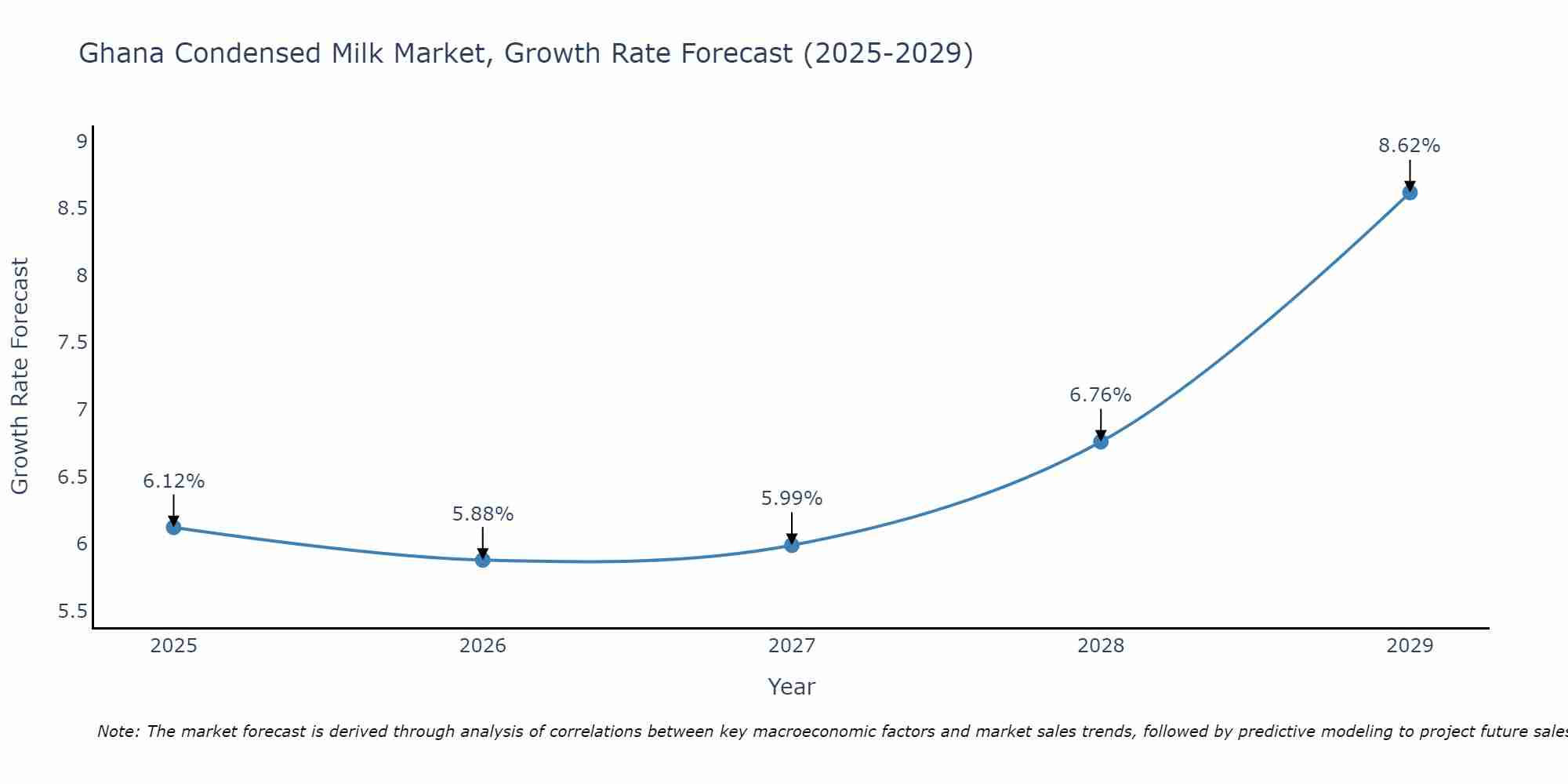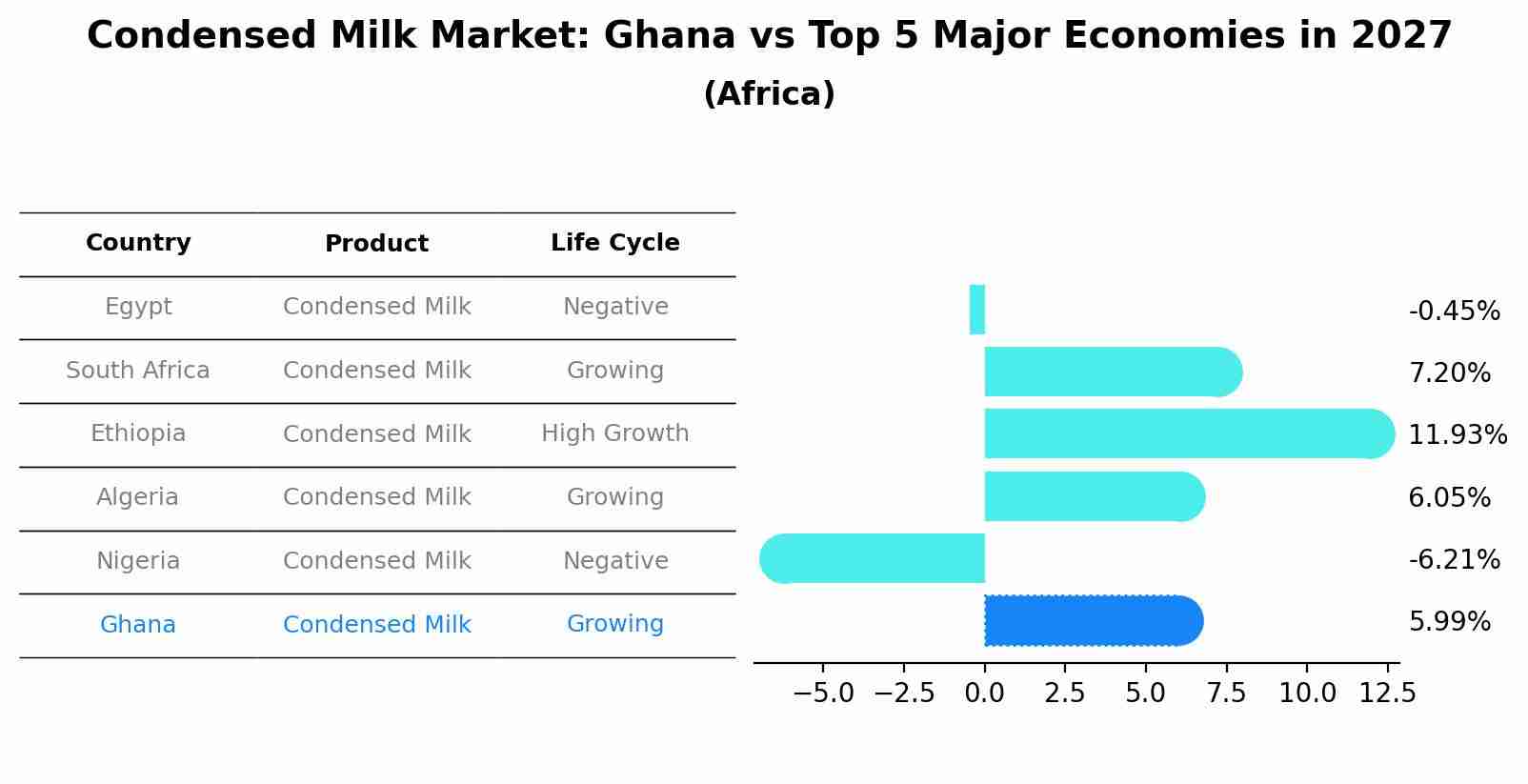Ghana Condensed Milk Market (2025-2031) Outlook | Growth, Industry, Trends, Size, Analysis, Value, Share, Companies, Revenue & Forecast
| Product Code: ETC381116 | Publication Date: Aug 2022 | Updated Date: Apr 2025 | Product Type: Market Research Report | |
| Publisher: 6Wresearch | Author: Shubham Padhi | No. of Pages: 75 | No. of Figures: 35 | No. of Tables: 20 |
Ghana Condensed Milk Market Size Growth Rate
The Ghana Condensed Milk Market is projected to witness mixed growth rate patterns during 2025 to 2029. Commencing at 6.12% in 2025, growth builds up to 8.62% by 2029.

Condensed Milk Market: Ghana vs Top 5 Major Economies in 2027 (Africa)
In the Africa region, the Condensed Milk market in Ghana is projected to expand at a growing growth rate of 5.99% by 2027. The largest economy is Egypt, followed by South Africa, Ethiopia, Algeria and Nigeria.

Ghana Condensed Milk Market Overview
The condensed milk market in Ghana serves consumer demand for sweetened, concentrated dairy products used in cooking, baking, and beverages. Condensed milk is made by evaporating most of the water content from cow`s milk and adding sugar to create a thick, creamy consistency with a sweet taste. In Ghana, condensed milk is a popular ingredient in traditional recipes such as desserts, sweets, and beverages, as well as modern applications in coffee and tea. Dairy manufacturers and brands in Ghana offer condensed milk products in various formats and packaging sizes to meet consumer preferences and culinary needs.
Drivers of the market
The popularity of condensed milk as a versatile ingredient in Ghana cuisine, coupled with its convenience and long shelf life, is driving the growth of the condensed milk market in the country. Increasing consumer disposable income and changing dietary preferences are also contributing to market expansion.
Challenges of the market
Challenges in the condensed milk market in Ghana include competition from imported dairy products and milk substitutes. Moreover, supply chain disruptions and distribution challenges impact market accessibility and affordability of condensed milk products for consumers.
Government Policy of the market
Recognizing the importance of condensed milk as a nutritious and convenient food product, the government may introduce policies to support the condensed milk market. These policies could include initiatives to promote local production of condensed milk from domestically sourced dairy ingredients, provide incentives for investment in dairy processing infrastructure and technology, and establish quality standards and regulations for condensed milk production and labeling. Additionally, the government may implement measures to support dairy farmers and producers in increasing milk production and quality, facilitate access to financing and technical assistance for dairy processing businesses, and promote consumer awareness about the nutritional benefits and versatility of condensed milk in various culinary applications.
Key Highlights of the Report:
- Ghana Condensed Milk Market Outlook
- Market Size of Ghana Condensed Milk Market, 2024
- Forecast of Ghana Condensed Milk Market, 2031
- Historical Data and Forecast of Ghana Condensed Milk Revenues & Volume for the Period 2021-2031
- Ghana Condensed Milk Market Trend Evolution
- Ghana Condensed Milk Market Drivers and Challenges
- Ghana Condensed Milk Price Trends
- Ghana Condensed Milk Porter's Five Forces
- Ghana Condensed Milk Industry Life Cycle
- Historical Data and Forecast of Ghana Condensed Milk Market Revenues & Volume By Product Type for the Period 2021-2031
- Historical Data and Forecast of Ghana Condensed Milk Market Revenues & Volume By Dairy for the Period 2021-2031
- Historical Data and Forecast of Ghana Condensed Milk Market Revenues & Volume By Non-Dairy for the Period 2021-2031
- Historical Data and Forecast of Ghana Condensed Milk Market Revenues & Volume By Packaging Type for the Period 2021-2031
- Historical Data and Forecast of Ghana Condensed Milk Market Revenues & Volume By Cans for the Period 2021-2031
- Historical Data and Forecast of Ghana Condensed Milk Market Revenues & Volume By Tubes for the Period 2021-2031
- Historical Data and Forecast of Ghana Condensed Milk Market Revenues & Volume By Bottles for the Period 2021-2031
- Historical Data and Forecast of Ghana Condensed Milk Market Revenues & Volume By Distribution Channel for the Period 2021-2031
- Historical Data and Forecast of Ghana Condensed Milk Market Revenues & Volume By Supermarkets and Hypermarkets for the Period 2021-2031
- Historical Data and Forecast of Ghana Condensed Milk Market Revenues & Volume By Convenience Stores for the Period 2021-2031
- Historical Data and Forecast of Ghana Condensed Milk Market Revenues & Volume By Specialty Stores for the Period 2021-2031
- Historical Data and Forecast of Ghana Condensed Milk Market Revenues & Volume By Online Retails for the Period 2021-2031
- Historical Data and Forecast of Ghana Condensed Milk Market Revenues & Volume By Others for the Period 2021-2031
- Ghana Condensed Milk Import Export Trade Statistics
- Market Opportunity Assessment By Product Type
- Market Opportunity Assessment By Packaging Type
- Market Opportunity Assessment By Distribution Channel
- Ghana Condensed Milk Top Companies Market Share
- Ghana Condensed Milk Competitive Benchmarking By Technical and Operational Parameters
- Ghana Condensed Milk Company Profiles
- Ghana Condensed Milk Key Strategic Recommendations
Frequently Asked Questions About the Market Study (FAQs):
- Single User License$ 1,995
- Department License$ 2,400
- Site License$ 3,120
- Global License$ 3,795
Search
Thought Leadership and Analyst Meet
Our Clients
Related Reports
- Afghanistan Apparel Market (2026-2032) | Growth, Outlook, Industry, Segmentation, Forecast, Size, Companies, Trends, Value, Share, Analysis & Revenue
- Canada Oil and Gas Market (2026-2032) | Share, Segmentation, Value, Industry, Trends, Forecast, Analysis, Size & Revenue, Growth, Competitive Landscape, Outlook, Companies
- Germany Breakfast Food Market (2026-2032) | Industry, Share, Growth, Size, Companies, Value, Analysis, Revenue, Trends, Forecast & Outlook
- Australia Briquette Market (2025-2031) | Growth, Size, Revenue, Forecast, Analysis, Trends, Value, Share, Industry & Companies
- Vietnam System Integrator Market (2025-2031) | Size, Companies, Analysis, Industry, Value, Forecast, Growth, Trends, Revenue & Share
- ASEAN and Thailand Brain Health Supplements Market (2025-2031) | Strategy, Consumer Insights, Analysis, Investment Trends, Opportunities, Growth, Size, Share, Industry, Revenue, Segments, Value, Segmentation, Supply, Forecast, Restraints, Outlook, Competition, Drivers, Trends, Demand, Pricing Analysis, Competitive, Strategic Insights, Companies, Challenges
- ASEAN Bearings Market (2025-2031) | Strategy, Consumer Insights, Analysis, Investment Trends, Opportunities, Growth, Size, Share, Industry, Revenue, Segments, Value, Segmentation, Supply, Forecast, Restraints, Outlook, Competition, Drivers, Trends, Demand, Pricing Analysis, Competitive, Strategic Insights, Companies, Challenges
- Europe Flooring Market (2025-2031) | Outlook, Share, Industry, Trends, Forecast, Companies, Revenue, Size, Analysis, Growth & Value
- Saudi Arabia Manlift Market (2025-2031) | Outlook, Size, Growth, Trends, Companies, Industry, Revenue, Value, Share, Forecast & Analysis
- Uganda Excavator, Crane, and Wheel Loaders Market (2025-2031) | Strategy, Consumer Insights, Analysis, Investment Trends, Opportunities, Growth, Size, Share, Industry, Revenue, Segments, Value, Segmentation, Supply, Forecast, Restraints, Outlook, Competition, Drivers, Trends, Demand, Pricing Analysis, Competitive, Strategic Insights, Companies, Challenges
Industry Events and Analyst Meet
Whitepaper
- Middle East & Africa Commercial Security Market Click here to view more.
- Middle East & Africa Fire Safety Systems & Equipment Market Click here to view more.
- GCC Drone Market Click here to view more.
- Middle East Lighting Fixture Market Click here to view more.
- GCC Physical & Perimeter Security Market Click here to view more.
6WResearch In News
- Doha a strategic location for EV manufacturing hub: IPA Qatar
- Demand for luxury TVs surging in the GCC, says Samsung
- Empowering Growth: The Thriving Journey of Bangladesh’s Cable Industry
- Demand for luxury TVs surging in the GCC, says Samsung
- Video call with a traditional healer? Once unthinkable, it’s now common in South Africa
- Intelligent Buildings To Smooth GCC’s Path To Net Zero


















